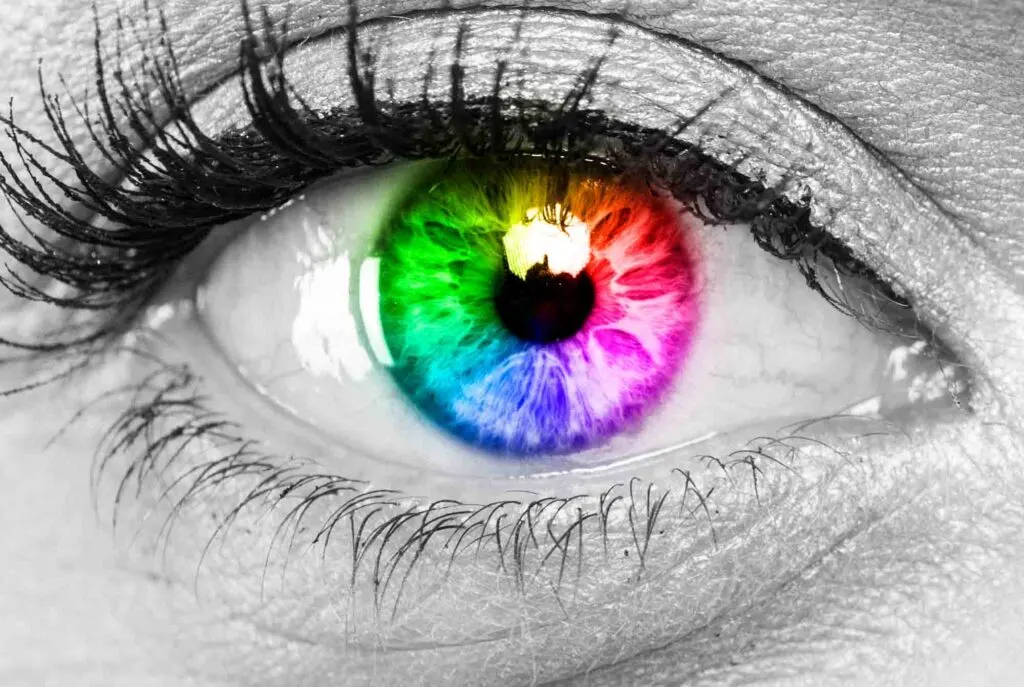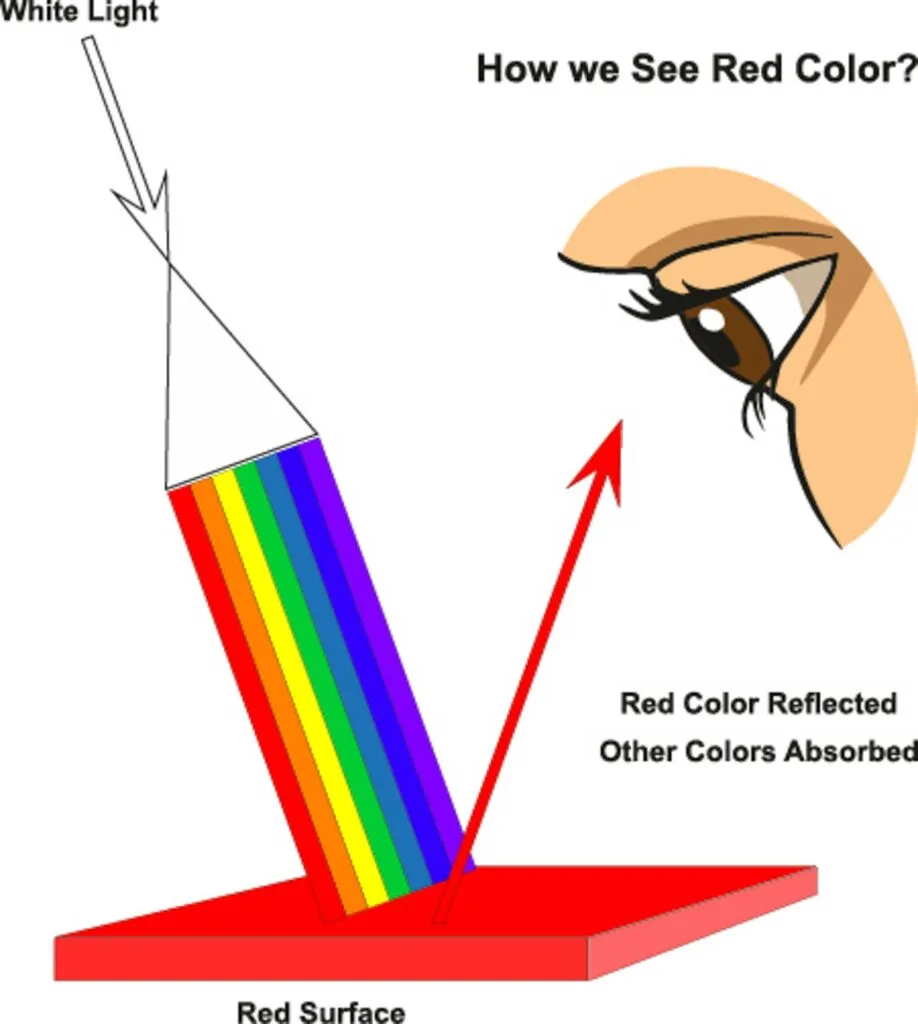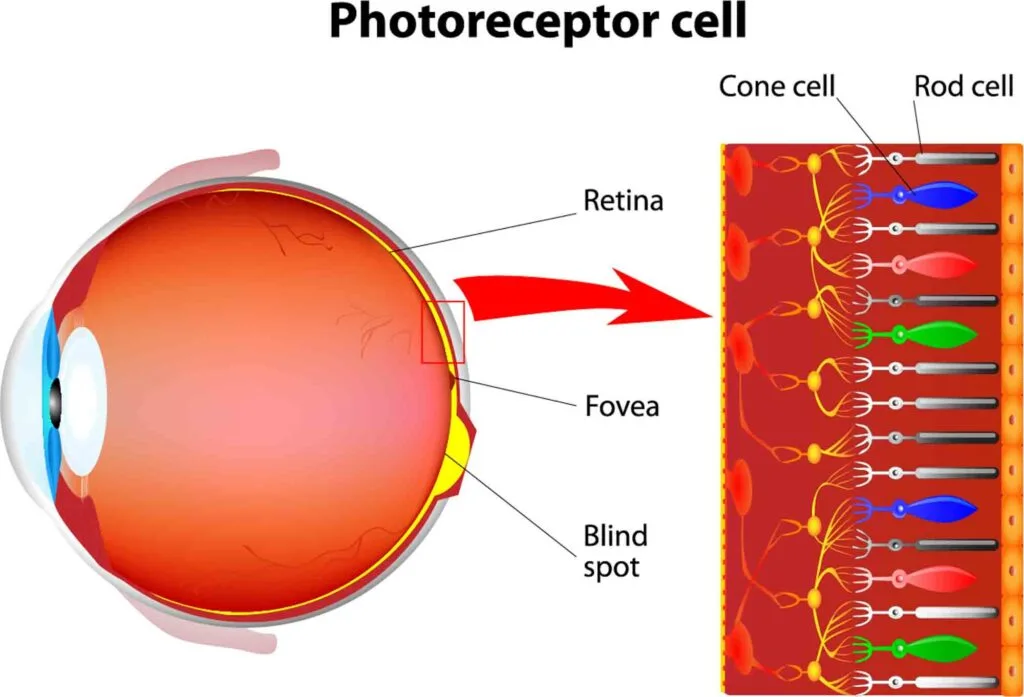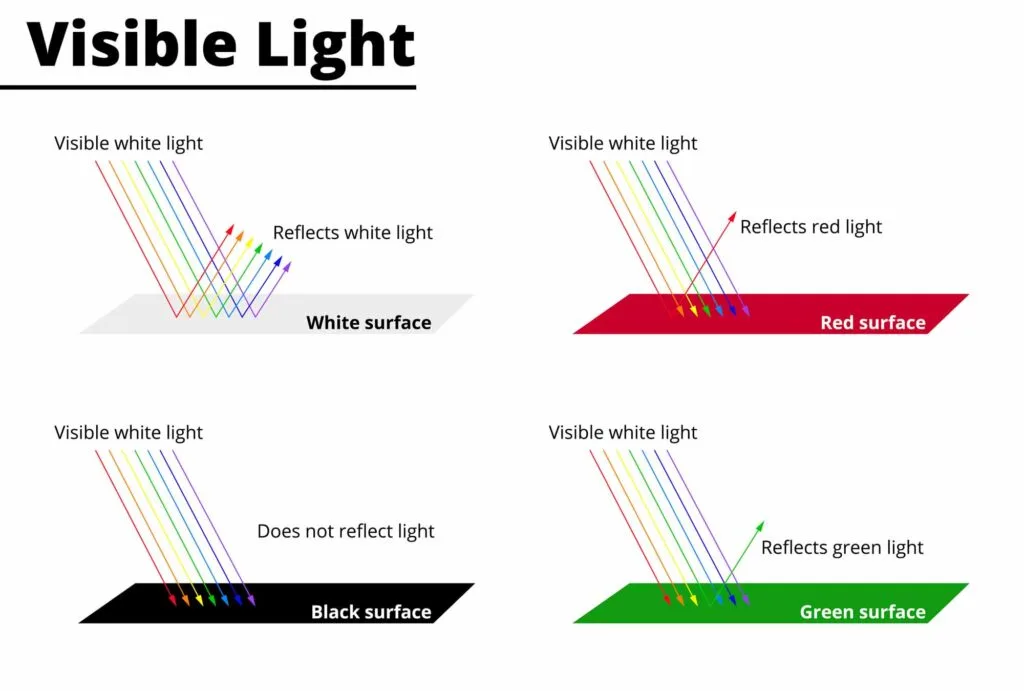Although colors are an essential part of our lives, there are many aspects we take for granted, like how do we see color?
Most of us have a favorite color, an affinity towards warm/cold colors, or use colors to describe various details about our world, but what exactly allows us to see colors? This article explores how and why we see the world around us in the colors we do.
If you’re curious about how our color vision works but would rather not spend hours poring over scientific articles or sifting through medical jargon, this article might provide the answers you’re looking for!

How Does Color Work?
Color is a fascinating combination of the properties of visible light, the characteristics of the material where light hits, and our eye’s ability to perceive the outcome.
If you’ve asked yourself, “What is color?” well, simply put, color is light and the eye’s perception of visible light—nothing more, nothing less.
All light is electromagnetic radiation, but our eyes can only see a small portion of the light spectrum.
For instance, radio waves and gamma rays, two frequencies on opposite ends of the electromagnetic spectrum, are invisible to us.
Well, visible light is a range of wavelengths between them that humans can actually see. They are called spectral colors, which fall between ultraviolet light and red light, producing a rainbow of colors:
- Indigo
- Violet
Although we see seven colors, they are, in fact, a product of the three primary colors: red, blue, and green (while green is a secondary color in art/painting, it’s a primary color in light/physics).
When these three colors mix in varying amounts, they produce the other millions of colors most of us are privileged to see.
What we perceive as “white light” is a combination of these colors in equal amounts.
Each color has a different wavelength. Red has the longest (700 nanometers), while violet has the shortest (380 nm) of the visible spectrum.
When striking an object, these light wavelengths react differently. Some objects absorb certain wavelengths, while others are reflected (and sometimes, wavelengths are scattered, like in the atmosphere, making the sky blue or red).
For example, if an object appears blue, it’s because it absorbed all the other color waves but reflected the blue waves of white light.
If the object is a mixture of colors, it reflects those colors while absorbing the remaining color(s). White objects reflect all the wavelengths, while black objects absorb them—that’s why you should avoid wearing dark clothes on hot days.

The Hue, Saturation, And Brightness Of Colors
Color comprises three elements, and the combination of these three characteristics is unique for each color.
Hue
The hue of color is red, orange, yellow, green, etc. The hue is also called the “aspect” or “character” of color and is the most discernible attribute in distinguishing different colors.
The hue is often the “richest” version of the color we see.
Saturation
The saturation (chroma or tone) of a color is how far it deviates from the hue (how much it looks like the “original” color).
An unmixed bright color is saturated, while a color with white added to it to make it paler or like a pastel color is unsaturated.
Although the color (hue) remains the same, it looks off (faded) from the original, thanks to the saturation.
Brightness
Brightness is the intensity (or value) of the light and how much energy the wave carries. The brightness does not change the hue or saturation level but makes the color appear sharper (more energy) or dull (less energy, like muted colors).
How Do We See Color?
While color relates to how an object interacts with light, how our brains interpret the information is equally (if not more) important to how we see color.
We recognize color as “color” because of the various structures in our eyes and the processing power of our brains.

The Biology Of Seeing In Color
How do we see color? Our eyes see color thanks to several complex processes and specialized cells.
Once visible light reflects off an object, the light enters our eyes through the eye structure, and the light particles (photons) reach the retina at the back of the eye. This critical zone contains photoreceptor cells for processing visual stimuli (information).
The two prominent types of photoreceptors are rods and cones.
Although humans have approximately 100 million rod cells, they are not involved with color differentiation. Rod cells help us see in dim light situations (night vision). Rods require low levels of photons to activate (scotopic vision).
There are roughly 6 million cone cells in the retina, divided into red, green, and blue cone types (pigments). For further image clarity and sharpness, many of these cone cells are clumped together in the “fovea” (a small hollow in the central portion of the retina).
Cones require more energy to activate (photopic vision).
These receptors “receive” photons that activate (supply energy to) proteins in the cell. Once activated, these proteins pass chemical and electrical signals (impulses) to the optical nerve, which transports the information to the brain.
A cone cell contains the protein “photopsins,” while rods contain “rhodopsin.”
Further out, there are three types of cones (pigments) that specialize in recognizing/processing red (long wavelength sensitive cones), green (middle wavelength sensitive), and blue (short wavelength sensitive).
Each of these cones recognizes roughly 100 different shades. However, there is a degree of overlap between the cones, which allows the eye to recognize other colors. Researchers believe the human eye can see over 1 million different colors.
These photoreceptors are “back-to-front,” so light energy moves to the eye’s posterior, where the receptors absorb the light. This strange orientation allows the surrounding cells to replenish the proteins used in communication and protects the eye from intense light.

How The Brain Interprets Color
Seeing color relates to more than the work of the eye.
For example, when white light illuminates a red apple, the apple absorbs green and blue light while reflecting the red.
This reflected wavelength finds its way to our eyes. The light enters and activates the red-receptor cones (thanks to the longer wavelength), which become energized and release the photopsin proteins. These proteins move through the optic nerve to the brain’s occipital lobe.
In the brain, the nerve impulse reaches the visual cortex (after passing through the thalamus). A different hemisphere of the brain processes each eye’s information.
Although the process is not fully understood, the visual cortex splits the information. It passes it to other regions in the brain, including the prefrontal cortex, which deals with memories, emotions, and sensory information to understand what you’re looking at.
Color relates to memory, so even though the lighting might change, our brains recognize and “remember” how a certain color looks and fill in the gaps. Our brains recognize the red apple as red thanks to the stimuli and the brain’s processing power. How incredible is that?
Not Everybody Sees The Same Color
Color perception refers to how a color subjectively appears or looks to the beholder.
Not all eyes and brains are the same, so that we may perceive color differently. Still, how do we see color differently, and why?
People interpret the same color differently for various reasons.

Men And Women See Color Differently
According to a study in 2010, women see more shades than men, particularly in the red and green colors. Females are also less likely to suffer from color impairments, like color blindness.
Color blindness affects roughly 1 in 200 women, while every 1 in 12 men is affected.
Color Impairments Result In Different Color Processing
Color vision deficiency (color blindness) is a condition where individuals struggle to differentiate between certain shades/hues.
This blindness is due to fewer certain color-sensitive pigments in the cones (i.e., fewer red, green, or blue-sensitive pigments). This lack of pigment means the eye is not as efficient at differentiating certain wavelengths of light.
The most common form is red-green blindness, while blue-yellow is rare. In exceptional cases, someone might have monochromacy (complete color blindness).
How Do Color Blind People See Color?
Red-green color blindness presents itself in 4 types:
Protanomaly – reds are dull and look greener.
Deuteranomaly – reduced sensitivity to green light.
Deuteranopia – unable to perceive green light.
Protanopia – unable to perceive red light.
Blue-yellow color blindness presents in two varieties:
Tritanomaly – reduced sensitivity to blue light (and difficulty identifying differences between blue and yellow, violet and red and blue and green).
Tritanopia – unable to perceive blue light.
Color blindness is most often a genetic condition; however, other circumstances can prevent people from seeing color, including:
Trauma (which makes it possible to be color blind in one eye and have normal color vision in the other eye)
Eye and neurological conditions (like glaucoma and multiple sclerosis)
Diabetes
Side effects of certain medications or exposure to harmful chemicals
Cancer
Final Words on How We See Color
Although this article has quite some technical words, I hope it helped you understand how our brain sees color and shows us this magnificent and colorful world we have.
Did you like this article about how we see color? Then share it on your social media!
